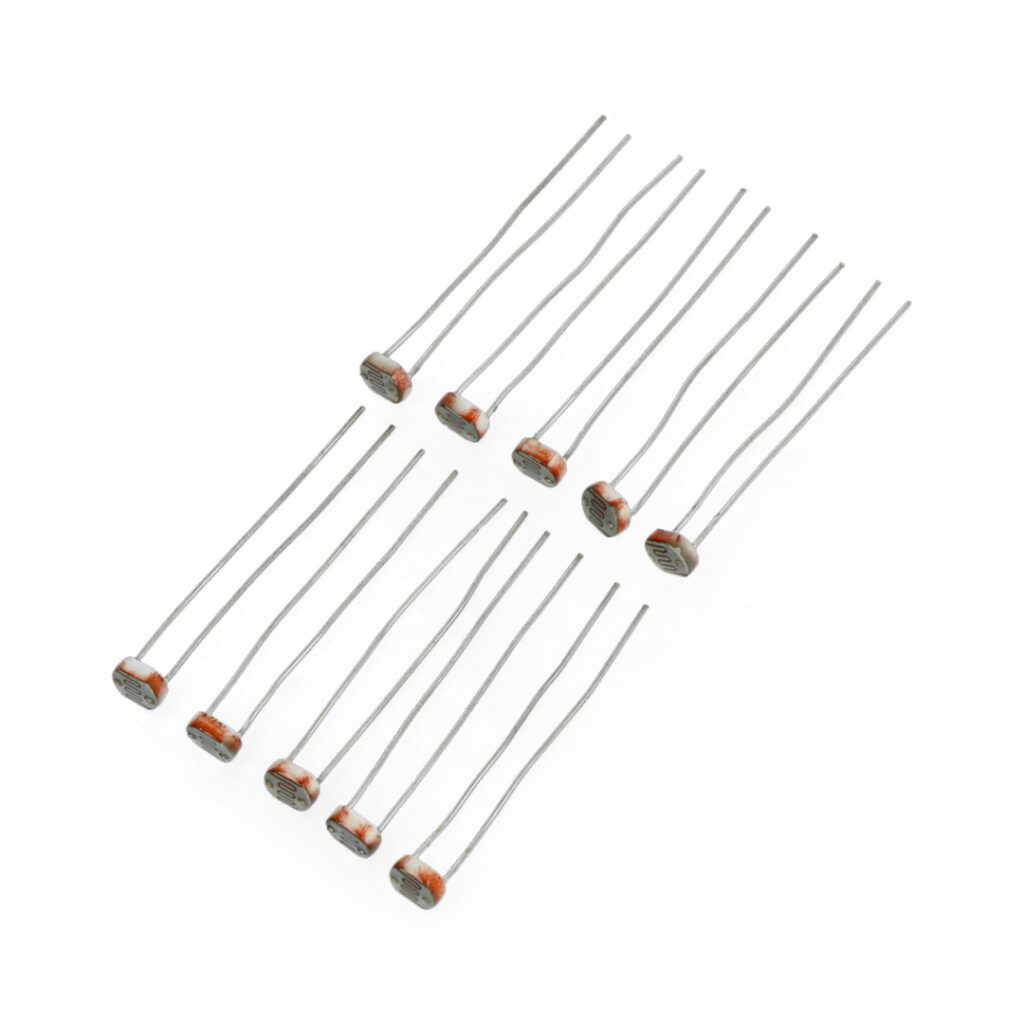Spis treści:
Photoresistors are important semiconductor components, without which modern electronics would look very different. Photoresist is an electronic component, Its electrical resistance, or resistance, varies with the intensity of light falling on it. Usually when it is exposed to light of higher intensity, then its resistance decreases. Let’s describe their work and applications in a nutshell.
How does a photoresist work?
When light falls on a photoresist, some valence electrons, i.e. electrons located on the outermost shell of the atom, absorb the energy of light and leave the valence shell. Valence electrons that leave the orbitals of an atom are called free electrons. A large number of valence electrons that leave the parent atoms “jump” to the conduction band. The electrons present in the conduction band do not belong to any atom, and therefore move freely from one place to another.
The valence electron that leaves the atom has a negative charge, this leads to a vacancy, and the atom gains a positive charge. This vacancy is called an electron hole (no electron in the full valence band). This is why free electrons and holes are generated as pairs. Free electrons that move freely from one place to another carry an electric charge.
In a similar way, holes moving in the valence band carry electric current. Similarly, both free electrons and holes will carry electric current. The amount of electric current flowing through a photoresist depends on the number of charge carriers generated, free electrons and holes. When the energy of light applied to the photoresist increases, the number of charge carriers generated in the photoresist also increases. As a result, the electric current flowing through the photoresist increases. An increase in electric current means a decrease in resistance, so the resistance of the photoresistor decreases as the light intensity increases.
Spontaneous and doped photoresistors
Spontaneous photoresistors are made of high-resistance semiconductors such as silicon or germanium. The outermost shell of most atoms can hold up to eight valence electrons. In the case of silicon or germanium, each atom has only four valence electrons. These four valence electrons of each atom form four covalent bonds with neighboring four atoms to completely fill the outermost shell. As a result, no electron remains free. When we apply light energy to a photoresist, only a small number of valence electrons gain enough energy and are released from the parent atom. Therefore, a small number of charge carriers are generated. As a result, only a small electric current flows through this type of photoresist. We already know that an increase in electric current means a decrease in resistance. In spontaneous photoresistors, the resistance decreases slightly as the light energy increases. Therefore, intrinsic photoresistors are less sensitive to light, and thus are not completely reliable in practical applications.
Doped photoresistors are made of various semiconductor materials. Consider an example of such a photoresist, which is made of a combination of silicon and doped-phosphorus atoms. Each silicon atom has four valence electrons, and each phosphorus atom has five valence electrons.
The four valence electrons of a phosphorus atom form four covalent bonds with neighboring four silicon atoms. However, the fifth valence electron of the phosphorus atom cannot form a fifth covalent bond with the silicon atom because the silicon atom has only four valence electrons. Therefore, the fifth valence electron of each phosphorus atom is released from the atom. Thus, each phosphorus atom generates a free electron. The generated free electron collides with the valence electrons of other atoms and makes them free. Similarly, a single free electron generates many free electrons.
Therefore, the addition of a small number of “impurity” atoms (phosphorus) generates millions of free electrons. In doped photoresistors, we already have a large number of charge carriers, so providing a small amount of light energy generates an even larger number of charge carriers. In this way, the electric current increases rapidly.
An increase in electric current means a decrease in resistance. The resistance of the external photoresistor decreases rapidly with a small increase in the applied light energy, so the reliability is higher than its predecessors.
Applications of photoresistors - what are photoresistors used for?
There are a whole lot of them. A good example is street lighting. Photoresistors are used in lanterns to control when the light should turn on and when it should turn off. When ambient light falls on the photoresist, it causes the streetlight to turn off. When there is no light, the photoresistor causes the streetlight to turn on. This naturally reduces electricity losses. Photoresistors can also be found in devices such as alarm devices, solar street lamps, nightlights and clock radios. The general areas of their application are photodetectors i “darkness sensors”, presence sensors in printers, scanners and paper feeding devices, cameras, reflective sensors used in computer mouse rollers, Solar monitoring systems, photovoltaics, thermostats, security systems, and even retro photography, where older cameras measured the amount of incident light and controlled the exposure time of the film.
Photoresistors - advantages, disadvantages, alternatives
Photoresistors are relatively simple to use and do not require complex circuitry. Simplicity is followed by low costs. Non-contact operation means there are no mechanical parts to break down. Vibration and vibration resistance and low power consumption compared to other light sensors are also essential advantages. Disadvantages include a slower response compared to a photodiode, temperature dependence affecting measurement precision, and susceptibility to interference from infrared sources. The first alternative has already been mentioned – a photodiode is more sensitive to light changes and has a faster response than a photoresistor, so it is used in applications that require precise measurement. On the common subject shelf you will find phototransistors, PIR sensors and laser light sensors, although the latter are used more in laser scanners and advanced measurements.
How useful was this post?
Click on a star to rate it!
Average rating 0 / 5. Vote count: 0
No votes so far! Be the first to rate this post.








